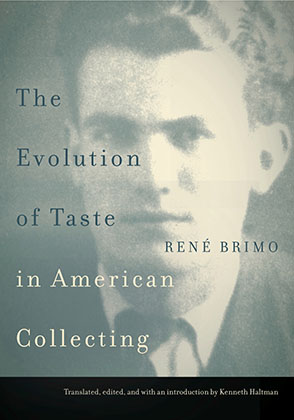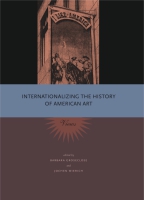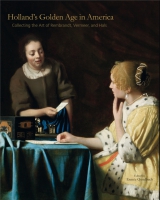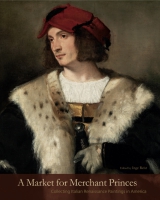
The Evolution of Taste in American Collecting
René Brimo, translated, edited, and with an introduction by Kenneth Haltman
The Evolution of Taste in American Collecting
René Brimo, translated, edited, and with an introduction by Kenneth Haltman
“Kenneth Haltman’s edition makes the book available in English and also provides a rich biographical and intellectual context for Brimo’s work, a most timely contribution to an emerging discipline of art market studies.”
- Description
- Reviews
- Bio
- Table of Contents
- Sample Chapters
- Subjects
In his introduction, Kenneth Haltman provides a biographical study of the author and his social and intellectual milieu in France and the United States. He also explores how Brimo’s work formed a turning point and initiated a new area of academic study: the history of art collecting.
Making accessible a text that has until now only been available in French, Haltman’s elegant translation of The Evolution of Taste in American Collecting sheds new critical light on the essential work of this extraordinary but overlooked scholar.
“Kenneth Haltman’s edition makes the book available in English and also provides a rich biographical and intellectual context for Brimo’s work, a most timely contribution to an emerging discipline of art market studies.”
“The judicious reader will find much to admire and much of scholarly value in Kenneth Haltman’s translation of René Brimo’s The Evolution of Taste in American Collecting. Brimo’s encyclopedic knowledge of his subject results in a host of penetrating observations about artists, critics, collectors, dealers, and institutions. Haltman’s introduction is a research tour de force that brings to light an extraordinary if mainly forgotten scholar and his opus magnum, hitherto virtually unknown to students of American art and history.”
“Brimo’s book is a remarkable, groundbreaking investigation of America’s evolving artistic tastes, a compendium of collectors—individual and institutional—and the cultural backdrops for their interests, an early history of museums in America, and a comprehensive overview of the literature of American art up to his time. Haltman’s translation makes this significant scholarly achievement more widely available and, thanks to his judicious editorial interventions, more reliable. His introduction brings to light—and to life—an intriguing personality.”
René Brimo (1911–1948) was an antiquarian dealer and a graduate of the École du Louvre, as well as a recipient of master’s degrees from Harvard and the Sorbonne and a docteur ès lettres from the University of Paris.
Kenneth Haltman is H. Russell Pitman Professor of Art History at the University of Oklahoma and the author of many books, including Looking Close and Seeing Far: Samuel Seymour, Titian Ramsay Peale, and the Art of the Long Expedition, 1818–1823, also published by Penn State University Press, and critical translations from the French, notably of works by Gaston Bachelard.
Contents
List of Illustrations vii
Acknowledgments ix
Making Sense of an Unusual Contribution to Art History 1
Notes 67
Kenneth Haltman
The Evolution of Taste in American Collecting 85
René Brimo
Preface 87
Introduction 89
Book 1:
Early Developments: From the Colonial Period to the
Philadelphia Centennial
Part 1: Colonial America
Looking Backward 96
Part 2: Science or Sentiment
[Historical Introduction, 1776–1840] 107
1 Encyclopedic Spirit 111
2 The Search for a National Style 121
Part 3: The Critical Era
[Historical Introduction, 1840–1876] 131
1 TheTaste for Anecdote and Realism 135
2 The Discovery of History 151
Book 2:
The Triumph of Quality: Major Collections from the Philadelphia Centennial to the Great War
[Historical Introduction, 1876–1919] 166
1 Eclecticism 171
2 The Notion of the “Old Master” 195
3 The Vogue for Archaeology and “Pre-History” 226
4 Staying in Touch with the Contemporary Scene 255
5 The Modern Art Museum 272
Conclusion 294
Notes 301
Bibliography 344
Index
INTRODUCTION
Although it is as difficult to define “taste” in the abstract as “beauty,” we may nevertheless trace its changing expressions throughout history. To this end the study of art collecting is among the most interesting possible.
Certain philosophers have demoted art collecting to the status of mere sport or speculation; others have seen it as but the result of economic privilege. While material conditions certainly are capable, in however limited a fashion, of splintering collections or dispersing them, they are insufficient to explain things more essential still such as the criteria collectors use, their taste itself, and variations in the quality of the works they assemble. Although art collecting might appear no more than a sophisticated game, it is one heavy in consequences both for collectors themselves and for the periods and social classes to which they belong. It is for this reason that it seems more accurate to view collecting as a creative act, part and parcel of artistic creativity itself.
It has not been my intention here to write a history of taste. The variety of its manifestations and the diversity of activities involved need must be far too numerous for that. Such work would properly include such cultural considerations as life style, dress, fashion, social role models, public behaviors, reading habits, even political ideas – in short, all the observable dimensions of a time, a nation, and a social milieu. My intentions must remain more limited and more precise.
It would be possible to conceive this subject as the history of collections; and yet an assemblage of brief monographic treatments devoted to individual collectors accompanied by inventories of their holdings seems more properly suited to catalogues and biographical dictionaries. The approach that I should like to take is different. Taste, by virtue of the role it plays in giving rise to collectors and museums alike, appears to me of primordial importance to the evolution of art. I have attempted therefore to work out the relationship between art in general and the formation of collections to determine if there is not some reciprocity of influence between the two, one in which collectors play an active role. Like art itself, perhaps more so, taste somehow is ever-changing and ephemeral. Every collection belongs to its period and milieu. There are, for example, numerous Middle Ages depending on the century and place from which that past is viewed. The Middle Ages of the English eighteenth century differ from those of the French romantics as from those of twentieth-century American archeologists. And yet, despite these shifts in mode, taste remains constant in its search for quality.
A collector can maintain a level of consistent quality only by virtue of a rigor of choice and a creative discretionary judgment comparable to those involved in the process through which a work of art forms in an artist’s imagination. Collectors, in this view, are artists themselves in search of works of art commensurate with their personal ideals that enable them to bring their own œuvre – the collection – to perfection. One might take this one step further to claim that in matters of taste collectors are the only true artists, for they enjoy the magnificent advantage of not being at once judge and judged. How else, if not as the result of individual creative acts, can we explain the emergence of veritable prodigy-collectors in places and societies otherwise entirely devoid of “taste”? [8]
In their choices collectors often give voice to completely hidden, previously unsuspected facets of their inner selves. They may discover in this way their own affinity for some artistic movement or personality or type. Again, a physiological dimension to the question of taste sometimes reveals itself in tendencies to purchase only certain media, materials, or colors, depending on the degree to which an individual enjoys a given visual or tactile sensibility. The color blind, for instance, are as a general rule little attracted to painting, and even in sculpture more moved by contour than volume. Epicurians, for example Philippe II, the Duke of Orléans, or August II of Saxony, were most strongly motivated in their preferences by sensual appeal.
In these ways “taste” enables us to reconstruct an individual’s sensibilities, especially where they express themselves, and flourish, only in that act of acquisition by which art collectors seek the purest and, indeed, most faithful image of their own desires, products in them of both dream and instinct. The compulsion to own, the almost carnal passion for possession that appeared in Europe along with private collections late in the eighteenth century, alone explains the seemingly innate ability of certain persons to “sniff out” the one object of worth amid a mass of mediocre works and imitations. That this sixth sense, this collector’s (or merchant’s) instinct, is often termed a “good nose” or a “good eye” demonstrates to what extent taste always has been felt to be a facet of human sensibility.
Collections, like works of art themselves, potentially express a love of country or nostalgia for a past age or for nature. Similarly, a collection may be born of the desire to live on after one’s death. A person’s name may be attached to a collection as to an institution, monument, tomb, hospital, or church. Sometimes, in fact, though well-known otherwise in their own time, officials, politicians, merchants, or industrialists come down to posterity in reputation only as collectors, their names intimately linked with some great work of art or artistic bequest.
Each piece in a collection, then, be it a painting, a work of sculpture, or an objet d’art, bespeaks the personality of its collector. Some trace of the collector may in fact be found in a collection’s every object, each a tangible, living document more objective in a sense and just as certain as anything we might learn from his or her personal relations or appearance. The collection itself rounds off our portrait of its owner and, as the concrete expression of the taste of an individual, can provide us means to further our understanding of a people in general.
While factors such as these must be kept continually in mind if we wish to arrive at an accurate and thorough understanding of taste as a phenomenon, it is necessary that we consider various external factors as well. Collections may express the flowering of sensibility and instinct in collectors who seek some connection with what lies beyond themselves. This may be the desire for moral uplift, a religious, spiritual magic that sometimes lies at the heart of (or at least helps to explain) a collector’s deepest-held convictions. In some eras moral or religious habit may dampen or even extinguish the taste for collecting, whereas at other times spiritual tendencies may favor or actually promote the development and refinement of artistic taste.
Sometimes taste is dictated more or less directly by historical events. While retaining a life of its own, public taste is intimately responsive to social and political interests associated for instance with the life of a nation or a monarch’s reign. Geographic situation and commercial and economic relations similarly affect modalities of taste. Contact between sufficiently different cultures may encourage the flowering of new developments. Though times of peace and social equili¬brium typically foster the birth of new collections, war and revolution have always provoked important changes as well, often involving massive migrations of works of art, [9] at times impoverishing or even dispersing entirely private as well as public collections.
Travel and the lure of distant lands have often led to a cultivation of exotic styles, as visible in art collecting as in art itself. During periods more patriotic or conventional, on the other hand, a powerful longing to connect with history may find expression in nostalgia, in the search for precedent or for continuity with previous epochs.
It is important to acknowledge here, as well, the role of education in instilling in some the desire to collect works of a given period or genre and so to materialize the image of a time and place. Books, specialized journals, newspapers, engravings, photo-reproductions, and gallery and museum exhibitions help collectors keep in touch with the world of art in all its various aspects, aware of the range of taste possible. A collector’s preferences, leading to the purchase of this or that object, may be aligned or, on the contrary, radically at odds with the work and taste of contemporary artists. A divorce is possible between the art of a period and the taste of contemporary collectors, each existing and functioning independently of the other.
Quite often one collects much as one dresses, for both acts are expressions of social decorum, signifiers of status. Taste for comfort, for adornment of the sort an art collection represents, are needs arising from personal proclivity but nurture as well. One’s era and city or country of origin, like the social class to which one has been born, are all factors that may lead one to collect. But it is equally true that oftentimes individuals will turn to collecting to escape the here and now, in order to discover in objects what is unavailable elsewhere.
Elites form in this way on the basis of shared sentiments and taste. Some may collect for no purpose other than to join the ranks of the enlightened, yet one must first cultivate one’s personal taste. Fashion trends and spurious snob appeal offer standards insufficiently reliable and too contingent to alone explain larger shifts in taste but may enable us better to grasp certain aspects of the taste of individual collectors, exemplifying as they do the amateur’s dependence on popular ideas.
The attitudes of collectors toward society can vary greatly. First of all there are eccentrics who amass works of art of a rather specialized nature, not unlike children who collect baseball cards or postage stamps. Their purpose may be well enough defined, but as the search for beauty is foreign to it their collecting, motivated simply by the desire to possess, is little related to society as a whole.
Alternatively, works of art may be considered uniquely as objects of value, as potentially lucrative investments. Though collections amassed on this basis have been particularly numerous in certain periods, they reveal little about taste per se and so, like the collections of eccentrics, remain beyond the scope of this study.
Other collectors have merely sought to heighten their own sense of material well-being. Focus on the decorative aspects of objects has always enjoyed wide appeal among art lovers everywhere. Many, on the other hand, see in works of art mere illustrations of the past, historical records documenting the life of a period, nation, or artist. They tend as a result to be drawn by the dating of a work, its signature or origins.
Interest in particular periods or styles leads to specialization. Such sharpening of focus may suggest a collector’s heightened sensibility, a style of creativity that functions by elimination, but more frequently an obvious deficiency in judgment liable to grow excessive. [10]
Another category of collecting is concerned uniquely with the object itself, unconcerned whether it forms part of a series, whether its price might rise or fall, whether it would harmonize well with an interior, whether it has been signed, or once belonged to someone famous, whether a bit of enamel, a sculpture, or a painting. Collectors of this sort, attracted more by an object’s intrinsic worth than by variable, artificial considerations, comprise a rarer and exalted breed: that of the veritable amateur.
Though this outline of differing attitudes toward collecting might appear somewhat schematic, these types do occasionally correspond to actual instances. More often, however, we encounter them in composite form, all mixed up together. The human complexity of most collectors, reflecting the richness of their lives, is rarely reducible to such strict categories. Neither do these differing attitudes evolve in any logical or continuous fashion but frequently in still distinguishable combinations. One may find it impossible, in fact, even when considering a single time or place, to note the predominance of any single type of collecting.
Two principal attitudes towards art may however be discerned among collectors: some seeking to preserve the art of the past; others, in the image of Mycænas, seeking instead to patronize contemporary innovation. Yet even these two tendencies, not mutually exclusive, coexist in individuals, evidencing equally their interest in keeping up with the times. Many have found some higher purpose in collecting, having come to understand the opportunity to admire, to love, to contemplate, and to study works of art as crucial to the future of the city or nation in which they live, even that of the culture more broadly defined. Rather than jealously safeguarding by hiding their collections, many have seen fit to share what they have gathered with the largest number possible. This philanthropic side to art collecting, this desire to share one’s enthusiasm and contentment with one’s fellows, has led to the founding of museums, gifts to public collections, and loans to exhibitions. The personalities of collectors have thus played an important role in stimulating the intellect and improving the quality of life in certain periods and places.
Historians of art collecting and of taste should bear in mind the variety of general types of amateurs and attitudes here enumerated. Where the infinitely more than ordinarily complex development of art collecting in the United States is concerned, however, this enumeration remains inadequate to frame discussion of historical change or to explain shifts in taste or fashion which seem as crucial to our understanding as more properly sociological or psychological factors common to the origins of collections everywhere.
While certain of the factors involved are material ones, a closer look at taste suggests that the availability of capital alone is insufficient to account for changes in collecting. On the contrary, often individuals of relatively modest means with faith in the works of art that they defend impel shifts in taste. The poverty of means of such amateurs is often compensated by a certain visibility and magnetism rendering the impact of their taste more expansive. An active interest taken even by few persons can prove more propitious for the propagation of new attitudes than might too great a popularity or rapid a success, which often tend to wind down, wear out, or dissolve new taste completely.
It is in circles such as these, large or small, more or less sophisticated or refined, that decisive shifts in taste take place, among them those I wish to study.
As in all things, in developments in taste one finds precursors and apostles, faithful followers and doubters; and the adversarial position of these last is often of more value to innovation than the support of those who would defend it. The worth of a movement [11] can be gauged by its detractors; nothing is more fatal to artistic innovation than complete indifference, harbinger of decadence. The art world itself often plays a large, even a primordial role in the history of taste. The work artists do makes them collectors first and only then creators of form They almost always will have sought inspiration and example in works of art, whether ancient or contemporary, and been led by some affinity of temperament, of lifestyle, or of style to surround themselves with examples they consider true to their own sensibility though quite often at odds with their own style. They thus find it possible to influence changing taste while often in their own work adhering to contemporary usages. Evolution in art may at times run parallel with developments in taste, as occurs in classical periods where the two go hand in hand, while at other times we see a clear divergence between artists and their cultural moment, as in the case of Rembrandt, the Romantics, and the Impressionists who had to struggle to impose their new ways of seeing, that is to say their taste, on others.
At the beginnings of all movements we find individuals with strong personalities, like everyone else beholden to tradition, to the artistic milieus to which they’ve been exposed, for such is the condition of all acts of human creativity. What matters to us here is the something new that results. Responsive and creative energies tend to impose themselves. Creative individuals – be they artists or collectors, dealers, critics, or teachers – attempt to expand their “following” through their art work, collections, courses, writings, speeches and activities. Such individual responses to the public life of a culture may be observed and studied as crystallized in collections. And new collections, by virtue both of their links with others of long standing and their own innovations, become influential in turn.
We can discover a variety of patterns in this movement of taste from individuals to the public sphere, from private holdings to museums and vice versa. The desire to achieve an absolute originality, like other snobbish, fashion-following infatuations is but one monstrous, factitious expression of this tendency, that all too often disrupts the search for quality which is, or ought to be, the true collector’s only purpose.
Let us take the opportunity therefore once again to acknowledge the range of human activities intimately associated with fluctuations in taste. And yet these many factors – material, social, intellectual, artistic; even historical discontinuities caused by the intervention of powerful personalities – remain insufficient to explain such shifts in taste entirely. They leave unanswered the key question concerning not just collections but the art world more generally: why do shifts occur in one direction and not another? We may pose the problem in the following fashion: does taste operate autonomously, evolving in the way that form evolves, in response to internal pressures?
Having posed the question, shedding all preconceived notions, we shall see what responses are afforded by the study of American collections. [12]
Mailing List
Subscribe to our mailing list and be notified about new titles, journals and catalogs.






